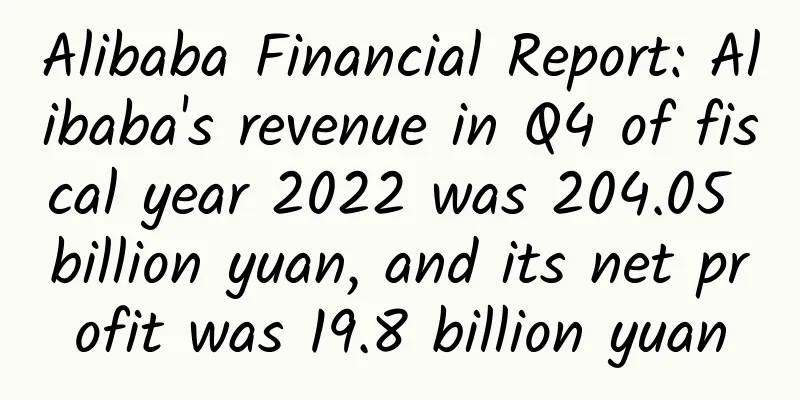Alibaba Financial Report: Alibaba's revenue in Q4 of fiscal year 2022 was 204.05 billion yuan, and its net profit was 19.8 billion yuan

|
Alibaba (NYSE: BABA; HK: 09988) recently released its fourth quarter and full-year financial report for fiscal year 2022 ending March 31, 2022 (Note: Alibaba's fiscal year is not synchronized with the calendar year, starting on April 1 of each year and ending on March 31 of the following year). The financial report shows that the company's fourth-quarter revenue was RMB 204.05 billion (approximately US$32.188 billion), a year-on-year increase of 9%. The net loss attributable to ordinary shareholders was RMB 16.241 billion (approximately US$2.562 billion). Non-GAAP net profit was RMB 19.799 billion (US$3.123 billion), down 24% year-on-year. In fiscal year 2022, Alibaba's total revenue was RMB 853.062 billion (US$134.567 billion), a year-on-year increase of 19%; net profit attributable to ordinary shareholders was RMB 61.959 billion (US$9.774 billion), a year-on-year decrease of 59%. Excluding non-GAAP items, net profit was RMB 136.388 billion (US$21.515 billion), a year-on-year decrease of 21%. Fourth quarter results: Revenue was RMB 204.052 billion (approximately US$32.188 billion), an increase of 9% compared with RMB 187.395 billion in the same period last year. Revenue from China's commercial retail business was RMB 135.947 billion (approximately US$21.445 billion), an increase of 7% from RMB 127.021 billion in the same period last year. Revenue from China's commercial wholesale business was RMB 4.383 billion (approximately US$692 million), an increase of 30% from RMB 3.370 billion in the same period last year. Revenue from international commercial retail business was RMB 9.887 billion (approximately US$1.56 billion), an increase of 4% from RMB 9.496 billion in the same period last year. Revenue from international commercial wholesale business was RMB 4.448 billion (approximately US$701 million), an increase of 13% from RMB 3.920 billion in the same period last year. Revenue from local consumer services was RMB 10.445 billion (approximately US$1.647 billion), a year-on-year increase of 29%. Revenue from Cainiao logistics services was RMB 11.582 billion (approximately US$1.827 billion), a year-on-year increase of 16%. Revenue from cloud computing business was RMB 18.971 billion (approximately US$2.993 billion), a year-on-year increase of 12%. Revenue from digital media and entertainment was RMB 8.005 billion (approximately US$1.263 billion), down 1% year-on-year, while revenue from innovation strategy and others was RMB 384 million (approximately US$60 million), down 35% year-on-year. Cost of revenue was RMB 138.945 billion (US$21.918 billion), accounting for 68% of revenue, while the cost of revenue in the same period last year was RMB 125.454 billion, accounting for 67% of revenue. Product development expenses were RMB 10.94 billion (US$1.726 billion), accounting for 5% of revenue, while product development expenses in the same period last year were RMB 13.302 billion, accounting for 7% of revenue. Sales and marketing expenses were RMB 27.20 billion (US$4.291 billion), accounting for 13% of revenue, while sales and marketing expenses in the same period last year were RMB 25.153 billion, accounting for 14% of revenue. General and administrative expenses were RMB 7.415 billion (approximately US$1.169 billion), accounting for 4% of revenue, while product development expenses in the same period last year were RMB 27.734 billion, accounting for 14% of revenue. Equity incentive expenses were a net write-back of RMB 3.737 billion (approximately US$590 million), compared with RMB 8.632 billion in the same period last year. Amortization of intangible assets was RMB 2.831 billion (approximately US$447 million), down 17% from RMB 3.415 billion in the same period last year. Operating profit was RMB 16.717 billion (approximately US$2.637 billion), accounting for 8% of revenue; while the operating loss in the same period last year was RMB 7.663 billion, accounting for -4% of revenue. Adjusted EBITDA was RMB 23.373 billion (approximately US$3.687 billion), down 22% from RMB 29.898 billion in the same period of 2021. Adjusted EBITA was RMB 15.811 billion (approximately US$2.494 billion), down 30% from RMB 22.612 billion in the same period of 2021. Interest and investment income was a loss of RMB 36.708 billion (approximately US$5.791 billion), compared with interest and investment income of RMB 111 million in the same period last year. Other income was RMB 1.62 billion (approximately US$323 million), compared with RMB 2.115 billion in the same period last year. Income tax expenses were RMB 2.079 billion (approximately US$328 million), compared with RMB 7.049 billion in the same period of 2021. The net loss was RMB 18.357 billion (approximately US$2.996 billion), compared with a net loss of RMB 7.654 billion in the same period last year. Non-GAAP net profit was RMB 19.799 billion (approximately US$3.123 billion), down 24% year-on-year. The net loss attributable to ordinary shareholders was RMB 16.241 billion (approximately US$2.562 billion), compared with a net loss of RMB 5.479 billion in the same period last year. The diluted loss per American depositary share was RMB 6.07 (approximately US$0.96), and the diluted loss per ordinary share was RMB 0.76 (approximately US$0.12 or HK$0.94). Excluding non-GAAP items, diluted earnings per American depositary share were RMB 7.95 (approximately US$1.25) and diluted earnings per ordinary share were RMB 0.99 (approximately US$0.16 or HK$1.22). Net cash outflow from operating activities was RMB 7.04 billion (approximately US$1.11 billion), compared with an inflow of RMB 24.183 billion (approximately US$3.691 billion) in the same period last year. The net cash used in investing activities was RMB 87.254 billion (approximately US$13.764 billion), and the net cash used in financing activities was RMB 10.614 billion (approximately US$1.675 billion). |
<<: CleverTap: Women account for 54% of e-commerce app usage in India
Recommend
Ranking of the most attractive tourist cities for international tourists in 2023
According to Euromonitor International, Istanbul,...
How much do you know about the jokes in the Spring Festival Gala? Come and understand the stories that have been forgotten for thousands of years
The tadpole wishes you a happy new year! Did ever...
Is the Dark Star reliable? Explaining hypersonic vehicles
The American military blockbuster "Top Gun 2...
Turning the computer off and on again does not equal restarting, don’t get it wrong!
Mobile phones have become our close "partner...
What should I do if Panax notoginseng flowers are moldy?
We all know that Panax notoginseng flowers can be...
What are the benefits of eating donkey-hide gelatin?
When it comes to donkey-hide gelatin paste, every...
The efficacy and function of the round fruit umbrella
The round-fruited parasol is a traditional Chines...
The efficacy and function of purple-backed scutellaria
Purple-backed Scutellaria baicalensis is a medici...
Should the word "Fu" be pasted upside down? How much do you know about Spring Festival couplets and the word "Fu"?
Tomorrow is the Little New Year. The Spring Festi...
The efficacy and function of willow chub
Willow choanx is a kind of traditional Chinese me...
I really want to ask: How many eggs is the healthiest to eat in a day?
There is a super ingredient that is available in ...
The role and efficacy of turtle skirt
We have all seen turtles in our lives. They are a...
Big news! The top ten scientific advances in China in 2021 are announced
On February 28, the High Technology Research and ...
Gray nails mean onychomycosis? Real onychomycosis has these symptoms →
Author: Tang Jiaoqing, attending physician of der...
Shark: I have walked sideways in the sea for tens of millions of years
Thanks to Spielberg's masterpiece "Jaws&...









